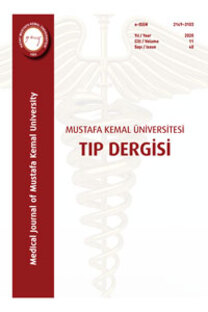HEMODİYALİZDE TÜNELLİ KATETERLER
hemodiyaliz, tünelli kateter, kateterlerin
Tunneled Catheters in Hemodialysis
hemodialysis, tunneled catheter, evaluate,
___
- 2009 Annual Data Report: Atlas of chronic kidney disease and end – stage renal disease in
- the United States. Am J Kidney Dis. 2010;55:S266–7.
- Vascular Access Work Group. Clinical practice guidelines for vascular access. Am J
- Kidney Dis.2006;48:S248–73.
- Varughese S, John GT, Alexander S, Deborah MN, Nithya N, Ahamed I, et al. Pre-tertiary
- hospital care of patients with chronic kidney disease in India. Indian J Med
- Res. 2007;126:28–33.
- Denys BG, Uretsky BF. Anatomical variations of internal jugular vein location: Impact on
- central venous access. Crit Care Med. 1991;19:1516–9.
- Denys BG, Uretsky BF, Reddy PS. Ultrasound-assisted cannulation of the internal jugular
- vein.A prospective comparison to the external landmark-guided
- technique. Circulation. 1993;87:1557–62.
- Molinari AC, Haupt R, Saracco P, Di Marco M, Castagnola E, Fratino G. Urokinase for
- restoring patency of malfunctioning or blocked central venous catheters in children with
- hemato-oncological diseases. Support Care Cancer. 2004;12:840–3.
- Fry AC, Stratton J, Farrington K, Mahna K, Selvakumar S, Thompson H, et al. Factors
- affecting long-term survival of tunnelled haemodialysis catheters-a prospective audit of 812
- tunnelled catheters. Nephrol Dial Transplant. 2008;23:275–81.
- Quarello F, Forneris G, Borca M, Pozzato M. Do central venous catheters have advantages
- over arteriovenous fistulas or grafts? J Nephrol. 2006;19:265–79.
- Mandolfo S, Galli F, Costa S, Ravani P, Gaggia P, Imbasciati E. Factors influencing
- permanent catheter performance. J Vasc Access. 2001;2:106–9.
- O’Dwyer H, Fotheringham T, O’Kelly P, Doyle S, Haslam P, McGrath F, et al. A
- prospective comparison of two types of tunneled hemodialysis catheters: The Ash Split versus
- the PermCath.Cardiovasc Intervent Radiol. 2005;28:23–9.
- Rao M, Juneja R, Shirly RB, Jacob CK. Haemodialysis for end-stage renal disease in
- Southern India--a perspective from a tertiary referral care centre. Nephrol Dial
- Transplant. 1998;13:2494–500.
- Astor BC, Eustace JA, Powe NR, Klag MJ, Fink NE, Coresh J. for the CHOICE study.
- Type of vascular access and survival among incident hemodialysis patients: The Choices for
- Healthy Outcomes In Caring ESRD (CHOICE) study. J Am Soc Nephrol. 2005;16:1449–55.
- ISSN: 2149-3103
- Yayın Aralığı: Yılda 3 Sayı
- Başlangıç: 2010
- Yayıncı: Hatay Mustafa Kemal Üniversitesi Tıp Fakültesi Dekanlığı
HEMODİYALİZDE TÜNELLİ KATETERLER
Celalettin Karatepe, Tülin Yetim, Cem Lale
İZOLE VENA SAFENA PARVA STRİPİNGİ SONRASINDA KOMPRESYON ÇORAPLARININ ETKİNLİĞİ: RETROSPEKTİF ÇALIŞMA
Mehmet Kaygın, Nail Kahraman, Ümit Halıcı, Özgür Dağ, Hüsnü Limandal, Ümit Arslan, Eyüp Çalık, Bilgehan Erkut
DELAYED EMERGENCE FROM ANESTHESIA ASSOCIATED WITH UNDIAGNOSED CENTRAL SLEEP APNEA SYNDROME
İşıl DAVARCI, Celalettin DAĞLI, Murat KARCIOĞLU, Kasım TUZCU, Selim TURHANOĞLU
Sedat Motor, Mukadder Keskin, Recep Dokuyucu
MUSTAFA KEMAL ÜNİVERSİTESİ TIP FAKÜLTESİ ÖĞRENCİLERİNDE KAN UYUMU
Recep Dokuyucu, Nebihat Sefil, Ayşegül Yiğit, Merve Karaca, Erhan Yengil
WOLFF PARKiNSON WHiTE SENDROMLU HASTANIN ANESTEZİ YÖNETİMİ: OLGU SUNUMU
Sedat HAKİMOĞLU, İşıl DAVARCI, Kasım TUZCU, Alper NACAR, Mustafa UĞUR, Cem ORUÇ, Ali SARI, Murat KARCIOĞLU
Selahattin TUĞRUL, Remzi DOĞAN, İlker OCAK, Sabri EREN, Orhan ÖZTURAN
GEBELİKTE İZLENEN PRİMER BAŞ AĞRILARI VE BU NEDENLE REÇETE DIŞI İLAÇ KULLANIMI
